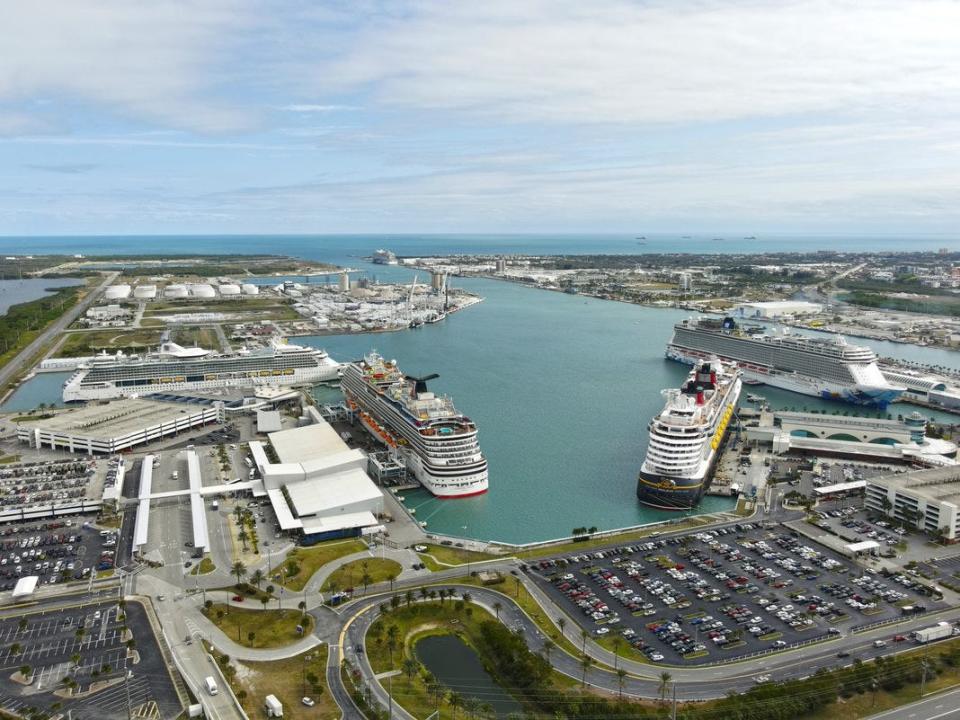5 things to know about parking issues at Port Canaveral, how port is seeking to address it
Port Canaveral's record-setting cruise passenger counts during the Christmas and New Year's period helped the port shatter its revenue projections.
But the influx of passengers to the port's 13 multiday cruise ships also brought to the forefront a spinoff issue: The port needed to make changes to its parking and traffic procedures.
Port Canaveral Chief Executive Officer John Murray said it is "totally unacceptable" for cruise passengers to spend 30 minutes or more trying to leave a Port Canaveral parking garage.

Murray said the port is working to solve the issues in advance of the next busy cruise period — a spring break time frame that stretches from the last week in February to the second week in April.
Here are five things to know about these issues:
How busy was the port's cruise operations during the holidays?
The port registered more than 700,000 passenger movements ― the combination of boardings and debarks — on its cruise ships during December. That includes more than 100,000 passenger movements on Dec. 23 and 24, and more than 96,000 on Dec. 30 and 31.
State of the Port:CEO Murray delivers upbeat report on state of Port Canaveral after record year
There are more ships based at Port Canaveral than ever before, and some of the ships are significantly larger than their predecessors.
What does that mean for the port's cruise revenue?
For the first three months of the port's budget year (Oct. 1 through Dec. 31), revenue from cruise ships and cruise passenger parking totaled $40.70 million, according to Port CFO Michael Poole. That's up $7.61 million or 23% from the amount budgeted for that period ― an estimate that was made before the fiscal year began.
So what's the issue?
One challenge is that so many people are driving in their personal vehicles to the port, and parking in a port garage, creating congesting in and around the parking areas.
The situation was exacerbated over the holidays at Cruise Terminal 10, which is used by MSC Cruises and Norwegian Cruise Line, in particular when there were several short cruises from that terminal in which an unusually large percentage of passengers drove to the port and had relatively little luggage.
Most everyone wanted to leave the parking garage at the same time after their cruise, creating extensive traffic congestion, as people tried to get out of their parking spaces, then pay their parking fees before exiting the garage.
Also, many cruise passengers are arriving at the port well before their scheduled boarding times, creating additional congestion, as they seek to enter port garages while passengers who just ended their cruises are leaving.
What does the port plan to do about that in the short term?
The port is switching to a system in which cruise passengers at Terminal 10 will pay upon entry to the garage, with parking lot attendants using handheld devices called a Clover system. Passengers pay a parking fee based on the length of their scheduled cruise.
Cruise industry awards:Cruise passenger poll names Port Canaveral as No. 1 port, Mardi Gras as best ship
Murray said the new system cuts the average transaction time to 20 seconds per vehicle. The previous pay-on-exit process took about 60 seconds per vehicle.
The port also is revamping traffic patterns for commercial shuttle buses and vans, as well as for Uber and Lyft ride-share drivers, to reduce congestion in the garage areas.
What about some longer-term measures?
The port is planning to make a series of changes to its parking garages, starting with Cruise Terminal 1, which is used by Royal Caribbean, and Cruise Terminal 10.
Among the changes are replacing what Murray describes as "antiquated" parking technology with a more advanced system.
Additionally, the new technology will help facilitate cruise passengers paying for parking using such methods as Apple Pay and SunPass.
The new technology is expected to be in use at Terminal 1 in November and at Terminal 10 by the end of December. Subsequently, Murray said, the technology will expand to the port's other cruise terminals.
The port also is creating new overflow parking lots to handle times when the existing parking garages might not be sufficient.
"We see a challenge, and are rising to it and fixing the problem," Murray said.
Contact Berman at dberman@floridatoday.com, on Twitter at @bydaveberman and on Facebook at www.facebook.com/dave.berman.54.
This article originally appeared on Florida Today: 5 things to know about Port Canaveral parking issues
